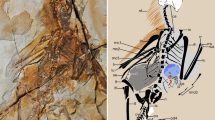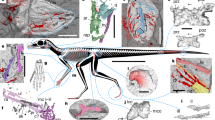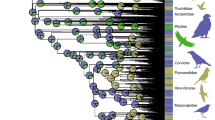Abstract
Although the dinosaurian hypothesis of bird origins is widely accepted, debate remains about how the ancestor of birds first learned to fly. Here we provide new evidence suggesting that basal dromaeosaurid dinosaurs were four-winged animals and probably could glide, representing an intermediate stage towards the active, flapping-flight stage. The new discovery conforms to the predictions of early hypotheses that proavians passed through a tetrapteryx stage.
This is a preview of subscription content, access via your institution
Access options
Subscribe to this journal
Receive 51 print issues and online access
$199.00 per year
only $3.90 per issue
Buy this article
- Purchase on Springer Link
- Instant access to full article PDF
Prices may be subject to local taxes which are calculated during checkout



Similar content being viewed by others
References
Ostrom, J. H. Osteology of Deinonychus antirrhopus, an unusual theropod dinosaur from the Lower Cretaceous of Montana. Peabody Mus. Nat. Hist. Bull. 30, 1–165 (1969)
Currie, P. J. Cranial anatomy of Stenonychosaurus inequalis (Saurischia, Theropoda) and its bearing on the origin of birds. Can. J. Earth Sci. 22, 1643–1658 (1985)
Norell, M. A., Clark, J. M., Chiappe, L. M. & Dashzeveg, D. A nesting dinosaur. Nature 378, 774–776 (1995)
Novas, F. E. & Puerta, P. New evidence concerning avian origins from the Late Cretaceous of Patagonia. Nature 387, 390–392 (1998)
Forster, C. A., Sampson, S. D., Chiappe, L. M. & Krause, D. W. The theropod ancestry of birds: new evidence from the Late Cretaceous of Madagascar. Science 279, 1915–1919 (1998)
Ji, Q., Currie, P. J., Norell, M. A. & Ji, S.-A. Two feathered dinosaurs from northeastern China. Nature 393, 753–761 (1998)
Xu, X., Wang, X.-L. & Wu, X.-C. A dromaeosaurid dinosaur with a filamentous integument from the Yixian Formation of China. Nature 401, 262–266 (1999)
Xu, X., Zhou, Z.-H. & Wang, X.-L. The smallest known non-avian theropod dinosaur. Nature 408, 705–708 (2000)
Zhou, Z.-H. & Zhang, F.-C. A long-tailed, seed-eating bird from the Early Cretaceous of China. Nature 418, 405–409 (2002)
Gauthier, J. A. Saurischian monophyly and the origin of birds. Mem. Calif. Acad. Sci. 8, 1–55 (1986)
Holtz, T. R. Jr The phylogenetic position of the Tyrannosauridae: implications for theropod systematics. J. Paleontol. 68, 1100–1117 (1994)
Holtz, T. R. Jr A new phylogeny of the carnivorous dinosaurs. Gaia 15, 5–61 (2000)
Sereno, P. C. The evolution of dinosaurs. Science 284, 2137–2147 (1999)
Norell, M. A., Clark, J. M. & Makovicky, P. in New Perspectives on the Origin and Early Evolution of Birds (eds Gauthier, J. & Gall, L. F.) 49–67 (Peabody Mus. Nat. Hist., Yale Univ., New Haven, 2001)
Xu, X., Norell, M. A., Wang, X.-L., Makovicky, P. & Wu, X.-C. A basal troodontid from the Early Cretaceous of China. Nature 415, 780–784 (2002)
Makovicky, P. & Sues, H.-D. Anatomy and phylogenetic relationships of the theropod dinosaur Microvenator celer from the Lower Cretaceous of Montana. Am. Mus. Novit. 3240, 1–27 (1998)
Norell, M. A. et al. ‘Modern’ feathers on a non-avian dinosaur. Nature 416, 36–37 (2002)
Smith, P. E. et al. Dates and rates in ancient lakes: 40Ar–39Ar evidence for an early Cretaceous for the Jehol Group, northeast China. Can. J. Earth Sci. 32, 1426–1431 (1995)
Jones, T. D., Farlow, J. O., Ruben, J. A., Henderson, D. M. & Hillenius, W. J. Cursoriality in bipedal archosaurs. Nature 406, 716–718 (2000)
Xu, X. Deinonychosaurian Fossils from the Jehol Group of Western Liaoning and the Coelurosaurian Evolution. PhD dissertation, Chinese Academy of Sciences (2002)
Norell, M. A. & Makovicky, P. J. Important features of the dromaeosaur skeleton: information from a new specimen. Am. Mus. Novit. 3215, 1–28 (1997)
Zhang, X.-H. et al. A long-necked therizinosauroid dinosaur from the Upper Cretaceous Iren Dabasu Formation of Nei Mongol, People's Republic of China. Vertebrata PalAsiatica 39, 282–290 (2001)
Sanz, J. L. et al. An Early Cretaceous bird from Spain and its implications for the evolution of avian flight. Nature 382, 442–445 (1996)
Zhang, F.-C. & Zhou, Z.-H. A primitive enantiornithine bird and the origin of feathers. Science 290, 1955–1959 (2000)
Beebe, C. W. A Tetrapteryx Stage in the Ancestry of Birds (Zooligica, New York, 1915)
Heilmann, G. The Origin of Birds (Witherby, London, 1927)
Burnham, D. A. et al. Remarkable new birdlike dinosaur (Theropoda: Maniraptora) from the Upper Cretaceous of Montana. Univ. Kansas Paleont. Contri. (new series) 13, 1–14 (2000)
Feduccia, A. & Tordoff, H. B. Feathers of Archaeopteryx: asymmetric vanes indicate aerodynamic function. Science 203, 1021–1022 (1979)
Ostrom, J. H. The cursorial origin of avian flight. Mem. Calif. Acad. Sci. 8, 73–81 (1986)
Padian, K. & Chiappe, L. M. The origin and early evolution of birds. Biol. Rev. 73, 1–42 (1998)
Burgers, P. & Chiappe, L. M. The wing of Archaeopteryx as a primary thrust generator. Nature 399, 60–62 (1999)
Chatterjee, S. The Rise of Birds (Johns Hopkins Univ. Press, Baltimore, 1997)
Yalden, D. W. Climbing Archaeopteryx. Archaeopteryx 15, 107–108 (1997)
Chiappe, L. M., Ji, S.-A., Ji, Q. & Norell, M. A. Anatomy and systematics of the Confuciusornithidae (Theropoda: Aves) from the late Mesozoic of Northeastern China. Bull. Am. Mus. Nat. Hist. 242, 1–89 (1999)
Hopson, J. A. in New Perspectives on the Origin and Early Evolution of Birds (eds Gauthier, J. & Gall, L. F.) 211–236 (Peabody Mus. Nat. Hist., Yale Univ., New Haven, 2001)
Zhou, Z.-H. & Farlow, J. O. in New Perspectives on the Origin and Early Evolution of Birds (eds Gauthier, J. & Gall, L. F.) 237–254 (Peabody Mus. Nat. Hist., Yale Univ., New Haven, 2001)
Sereno, P. & Rao, C. Early evolution of avian flight and perching: new evidence from the Early Cretaceous of China. Science 255, 845–848 (1992)
Arnold, E. N. in New Perspectives on the Origin and Early Evolution of Birds (eds Gauthier, J. & Gall, L. F.) 195–210 (Peabody Mus. Nat. Hist., Yale Univ., New Haven, 2001)
Norberg, U. M. Evolution of vertebrate flight: an aerodynamic model for the transition from gliding to active flight. Am. Nat. 126, 303–327 (1985)
Norberg, U. M. in The Beginnings of Birds (eds Hecht, M. K., Ostrom, J. H., Viohl, G. & Wellnhofer, P.) 293–302 (Freunde des Jura-Museums Eichstatt, Eichstatt, 1985)
Norberg, U. M. Vertebrate Flight (Springer, Berlin, 1990)
Rayner, J. M. V. in The Beginnings of Birds (eds Hecht, M. K., Ostrom, J. H., Viohl, G. & Wellnhofer, P.) 279–288 (Freunde des Jura-Museums Eichstatt, Eichstatt, 1985)
Rayner, J. M. V. in The Beginnings of Birds (eds Hecht, M. K., Ostrom, J. H., Viohl, G. & Wellnhofer, P.) 289–292 (Freunde des Jura-Museums Eichstatt, Eichstatt, 1985)
Bock, W. J. The arboreal origin of avian flight. Mem. Calif. Acad. Sci. 8, 57–72 (1986)
Rowe, T. et al. The Archaeoraptor forgery. Nature 410, 539–540 (2001)
Speakman, J. R. & Thomson, S. C. Flight capabilities of Archaeopteryx. Nature 370, 524 (1994)
Acknowledgements
We thank L. Witmer and A. Milner for their suggestions and comments, M. Norell, X.-J. Ni, J. Liu, J. Clarke and P. Sereno for discussions, Y.-L. Huo, Y.-T. Li and H.-J. Wang for preparing the specimens, R.-S. Li for drawings, and Z.-G. Sun and B. An for help with CT scanning. Thanks also go to members of the Liaoxi expedition team of the IVPP for fieldwork. This work was supported by grants from the National Natural Science Foundation of China, the National Geographic Society, Special Funds for Major State Basic Research Projects of China, and the Chinese Academy of Sciences.
Author information
Authors and Affiliations
Corresponding author
Ethics declarations
Competing interests
The authors declare that they have no competing financial interests.
Rights and permissions
About this article
Cite this article
Xu, X., Zhou, Z., Wang, X. et al. Four-winged dinosaurs from China. Nature 421, 335–340 (2003). https://doi.org/10.1038/nature01342
Received:
Accepted:
Issue Date:
DOI: https://doi.org/10.1038/nature01342
This article is cited by
-
Origin of the propatagium in non-avian dinosaurs
Zoological Letters (2023)
-
Intestinal preservation in a birdlike dinosaur supports conservatism in digestive canal evolution among theropods
Scientific Reports (2022)
-
Pterosaur melanosomes support signalling functions for early feathers
Nature (2022)
-
Molecular phyloecology suggests a trophic shift concurrent with the evolution of the first birds
Communications Biology (2021)
-
‘Dinosaur-bird’ macroevolution, locomotor modules and the origins of flight
Journal of Iberian Geology (2021)
Comments
By submitting a comment you agree to abide by our Terms and Community Guidelines. If you find something abusive or that does not comply with our terms or guidelines please flag it as inappropriate.



